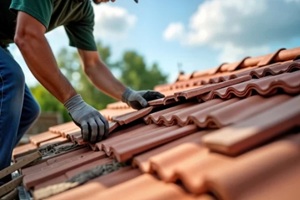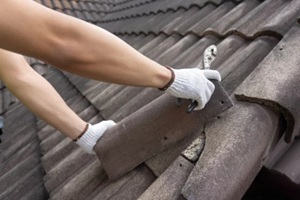
2024 was the fourth-costliest year on record for weather-related property damage, with 27 weather events each causing over $1 billion in damages. This has resulted in skyrocketing roof damage claims, which vary widely in value depending on the size of the home and the materials that need to be replaced. In some cases, a roof replacement can cost up to $45,000.
Thankfully, most homeowners can expect to spend far less, especially with an expert roof replacement contractor guiding the process. Additionally, as the housing economy is keeping homeowners in their homes longer, many are seeing their roof warranties come close to expiring.
If your roof has been damaged, showing signs of wear and tear, or your warranty is close to expiring, this article provides a complete guide to the roof replacement process, including a list of the causes of roof damage, an estimate of the costs, and the steps you can take to ensure the process is successful.
When Should I Replace My Roof?
If your roof has been damaged or the material warranty is nearly expired, this is a perfect time to evaluate the status of your roof and determine whether you would benefit from a repair or replacement. These questions can guide that decision:
1. Are the shingles damaged?
Shingles can become curled, cracked, or worn away through normal wear and tear, sun exposure, or storm damage. Over time, they also lose their granules, which are small asphalt stones embedded into most shingles to offer extra protection. If you notice any of these signs of damage, your roof may need repair or replacement.
2. Are there new cracks or stains in the ceiling?
For many homeowners, cracks or stains in their ceilings are the first visible signs of wear and tear on their roofs. When shingles and roof membranes weaken, water can seep in, swelling and expanding materials and causing cracks.
3. Is the flashing damaged?
Metal flashing on the roof guides water away from critical structures such as vents and chimneys. If flashing is missing, lifted, or shows signs of visible damage, this is a strong indicator that it may be time for a roof replacement. Although homeowners may be inclined to replace only the flashing, a roof inspection should be completed to identify interior roof damage.
4. Has my energy bill gone up?

Rising energy bills have hit everyone this past winter season. However, they can also be a sign of roof damage. Compromised materials inside and outside of the roof often result in less temperature resilience as heat and air leak in and out of your home, raising the monthly cost of temperature regulation.
What Does a Roof Replacement Cost?
Every roof repair is different, bu the cost of a roof replacement depends on similar factors:
- The size and shape of your roof determines the amount of materials needed and the labor costs.
- The materials you choose can vary widely from lower cost materials (asphalt) to more expensive materials which are typically more energy-efficient (slate or metal).
- The cost of labor can differ depending on your contractor’s terms, the project timeline, and the cost of disposing of your old roof.
- The cost of repairs that may be necessary prior to replacing your roof since water damage to the underlayment and other materials may need to be addressed first.
- The status of your warranty could save money on covered material and labor costs if the warranty is still active.
It is recommended that homeowners be diligent with contractors about cost estimations. Ask how each of these key factors impacts the project cost to determine whether the project is within your budget.
Step-by-Step Guide to Roof Replacement
- Initial Inspection: The initial inspection will allow the contractor to assess the damage and determine the replacement plan.
- Material Delivery: Once the roof replacement material has been selected, the new roof will be delivered to the home on pallets and stored until contractors begin the process.
- Repair, Removal, and Replacement: Contractors will remove the old roof and inspect the underlayment and supports for damage. In many cases, water leakage or pests have damaged these structures over time. Repairs must be completed before the new materials are installed.
- Clean-up: Roof replacements create a lot of debris, including roofing nails and old materials. Once the new roof is in place, contractors should clean the property while moving their equipment out.
- Last Inspection: To ensure the new roof is secure and the flashing, vents, and other structures have been addressed, the contractor should examine the new roof and review any last-minute details with the homeowner.
Deviations in this basic schedule may arise from delays caused by material delivery, home or property preparations, safety regulations, or unexpected repairs. However, your contractor will walk you through the process at each step to explain how any changes to the plan can impact your budget and timeline estimations.
Contact Expert Exteriors for Your Roof Replacement Project

A roof replacement provides more than just a new look; it enhances energy efficiency, extends the roof warranty, and strengthens your home’s protection. Since roof damage isn’t always easy to spot, a professional inspection is key to determining the right time for a replacement.
At Expert Exteriors, we guide Northern Virginia and Maryland homeowners through every step of the roof replacement process. Contact our team today to schedule a consultation and discover how we can ensure a seamless, stress-free upgrade for your home.
